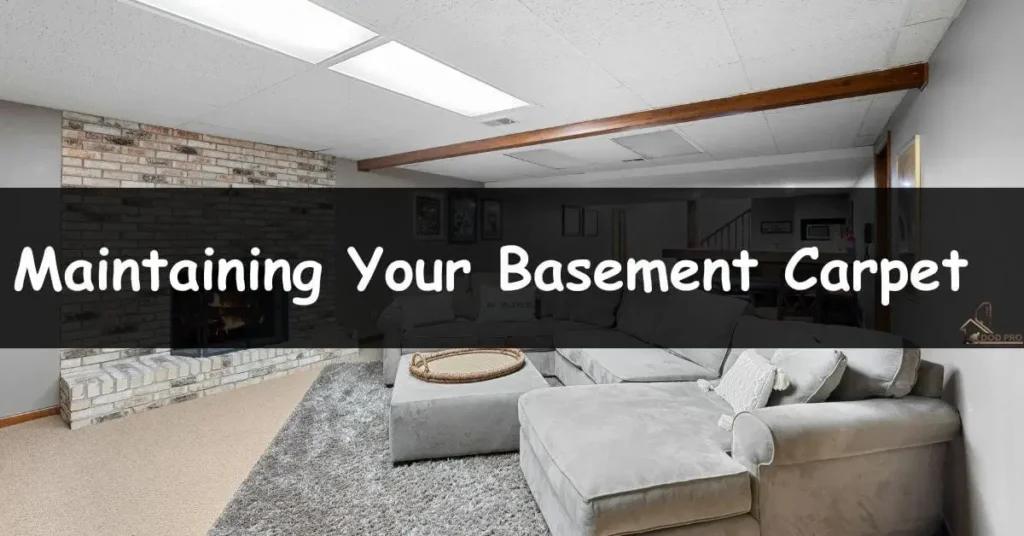If you’re wondering how to install carpet in a basement, you’re not alone. Many homeowners look to add carpet to a basement to make the space warmer and more inviting. While it may seem like a big task, installing carpet over concrete is something you can do yourself with the right approach. In this guide, we’ll take you through each step, so you can tackle the project with confidence.
Curious about how to install carpet on stairs? Click here for a simple, step-by-step guide!
Why Choose Carpet for a Basement?
Basements can feel cold and unwelcoming, especially with bare concrete floors. Carpet adds warmth, reduces noise, and creates a cozy space. With the right materials and proper installation, your basement carpet can last for years.
Things to Consider Before Installing Carpet

Before you start, consider these important factors:
- Moisture Issues – Basements are prone to dampness. Make sure the floor is dry and install a vapor barrier if necessary.
- Type of Carpet – Choose a moisture-resistant carpet designed for basements.
- Padding – A good carpet pad improves comfort and extends carpet life.
- Installation Method – You can install carpet using adhesive, tack strips, or carpet tiles.
Tools and Materials You’ll Need
- Carpet of your choice
- Carpet padding
- Tape measure
- Utility knife
- Tack strips
- Carpet stretcher
- Knee kicker
- Adhesive (if needed)
- Hammer and nails
- Vacuum cleaner
How to Install Carpet in a Basement
Here are the steps to properly install carpet in a basement. Use these steps to ensure a successful installation
Step 1: Prepare the Basement Floor
Start by cleaning the concrete floor thoroughly. Remove dust, dirt, and debris using a vacuum or broom. If the floor has cracks, patch them with concrete filler. Make sure the surface is dry before moving on.
Step 2: Install a Moisture Barrier (If Needed)
If your basement is prone to moisture, install a vapor barrier. This thin plastic sheet prevents moisture from seeping into the carpet. Lay it across the floor and secure it with adhesive or tape.
Step 3: Install Carpet Padding
Carpet padding adds comfort and extends the life of your carpet. Cut the padding to fit the room, leaving a small gap along the walls. Secure it using adhesive or carpet tape.
Step 5: Install Tack Strips
For traditional carpet installation, tack strips are essential for securing the carpet. Place them along the room’s edges, leaving a small gap from the wall. Use masonry nails to fasten them to the concrete, or opt for adhesive if nails aren’t suitable
Don’t have tack strips? Click here to learn how to install carpet on concrete without them.
Step 6: Lay the Carpet
Roll out the carpet over the padding. Leave extra carpet along the edges to trim later. If you’re using carpet tiles, arrange them in a pattern before securing them with adhesive.
Step 7: Stretch and Secure the Carpet
For wall-to-wall carpet, use a carpet stretcher and knee kicker to pull the carpet tight. Attach the edges to the tack strips, then trim the excess carpet along the walls using a utility knife.
Step 8: Finish the Edges
Once the carpet is in place, tuck the edges under the baseboards for a clean look. If needed, use transition strips to connect the carpet to other flooring types.
Best Carpet Options for Basements
Choosing the right carpet is essential for durability and comfort. Here are some of the best options:
- Low-Pile Carpet – Easier to clean and less prone to moisture issues.
- Berber Carpet – Durable and moisture-resistant.
- Carpet Tiles – A great choice for DIY installation and easy replacement.
- Waterproof Carpet – Specially designed to resist moisture and mold.
Maintaining Your Basement Carpet

Proper maintenance is key to keeping your basement carpet in top shape. Vacuum regularly to remove dirt and debris that can cause wear over time. If your basement is prone to humidity, using a dehumidifier can help prevent moisture buildup and reduce the risk of mold and mildew.
Always clean spills immediately to avoid stains and long-term damage. Additionally, check for leaks and address any water issues before they affect your carpet. Taking these simple steps will help extend the life of your basement carpet and keep it looking fresh.
Conclusion
Installing carpet in a basement is a great way to add warmth and comfort. With the right preparation and materials, you can create a cozy, stylish space. Whether you choose traditional carpet, carpet tiles, or waterproof options, proper installation will ensure long-lasting results.
FAQs
Q1: Can I install carpet on a concrete basement floor?
A: Yes, but you need to prepare the surface properly. A moisture barrier and carpet padding will improve comfort and durability.
Q2: What’s the best carpet for basements?
A: Low-pile, Berber, and waterproof carpets are great options. Carpet tiles are also a practical choice for basements.
Q3: Do I need a vapor barrier under the carpet?
A: If your basement is prone to moisture, a vapor barrier is highly recommended. It helps prevent mold and mildew.
Q4: How do I keep my basement carpet from getting moldy?
A: Use a dehumidifier, clean spills immediately, and ensure proper ventilation. Choosing a moisture-resistant carpet also helps.
Q5: Can I install carpet without tack strips?
A: Yes, you can use adhesive, carpet tape, or carpet tiles as an alternative to tack strips.


